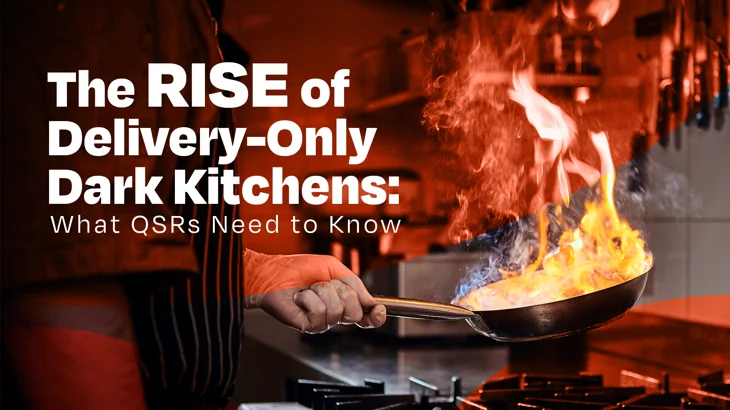In recent years, the Quick Service Restaurant (QSR) industry has seen a significant shift toward delivery-focused operations. Dark kitchens, often referred to as ghost kitchens or cloud kitchens, are redefining the way food is prepared and delivered. These kitchens, which operate without dine-in facilities, focus solely on fulfilling online orders. For QSR owners with already existing stores, understanding this model is crucial as it could significantly impact your operations, growth strategy, and customer experience. Here’s what you need to know about the rise of dark kitchens and how they could affect your business.
1. What Are Delivery-Only Kitchens?
Delivery-only kitchens are facilities optimised for food preparation and delivery. They typically lack a physical storefront and serve customers exclusively through online platforms. For small to medium-sized QSR chains, these kitchens:
- Focus on preparing food for delivery via your own app if you have your own delivery drivers and apps like Uber Eats, Just Eat, and Deliveroo.
- Operate with lower overhead costs by eliminating the need for dine-in space and staff.
- Offer an opportunity to test new markets or menu items without the expense of a full-scale location.
2. Why Are They Growing in Popularity?
Several factors have contributed to the rapid growth of delivery-only kitchens:
- Increased Demand for Food Delivery: The convenience of online ordering has made delivery a preferred option for many consumers, especially following the pandemic.
- Cost Efficiency: Without the need for dine-in services, delivery-only kitchens save on rent, utilities, and staffing—a significant benefit for QSR owners managing tight budgets.
- Market Expansion Opportunities: These kitchens allow small QSR chains to expand into new areas without the risk and cost of opening traditional brick-and-mortar locations.
3. Key Benefits for QSRs with existing Locations
For QSRs with a few existing stores, adopting a delivery-only kitchen model offers several advantages:
- Cost-Effective Growth: Instead of investing in full-scale restaurants, delivery-only kitchens provide a leaner way to enter new markets or increase capacity in high-demand areas.
- Operational Flexibility: These kitchens can be set up relatively quickly, enabling you to adapt to market changes or seasonal demand.
- Experimentation: You can test new menu items, cuisines, or virtual brands without disrupting operations at your main locations.
4. Challenges Specific to Small QSR Chains
While the benefits are clear, smaller QSR chains face unique challenges when adopting delivery-only kitchens:
- Balancing Resources: Limited staff and management bandwidth may make it difficult to oversee both traditional and delivery-only operations.
- Dependence on Third Parties: Relying on delivery platforms can eat into profits due to high commission fees and limited control over customer interactions. Ensuring direct Traffic is important.
- Brand Visibility: With no physical storefront, you may struggle to maintain brand recognition and loyalty in competitive markets.
- Maintaining Quality: Ensuring food quality and consistency during transit can be more difficult when scaling delivery operations.
5. How to Overcome These Challenges
To successfully integrate delivery-only kitchens into your QSR operations, consider these strategies:
- Invest in Training and Technology: Equip your team with the tools and knowledge to manage delivery-only kitchens effectively. Use kitchen management software to streamline processes and reduce errors.
- Optimise Your Menu: Focus on delivery-friendly items that maintain quality during transit and simplify kitchen workflows.
- Build a Strong Online Presence: Invest in digital marketing and maintain active engagement on social media to compensate for the lack of a physical storefront.
- Negotiate with Delivery Platforms: Work to secure better commission rates or explore hybrid models where customers can order directly from your app or website.
6. Leveraging Automation and AI
For QSRs with limited resources, automation and artificial intelligence (AI) can be critical enablers of delivery-only kitchens:
- Automated Food Prep: Implementing smart appliances can help manage labor shortages and ensure consistency.
- Demand Forecasting: AI tools can predict order volumes, helping you plan inventory and staffing efficiently.
- Route Optimisation: Use AI-powered solutions to streamline delivery logistics and reduce delays, enhancing customer satisfaction.
7. Future Trends for Small QSR Chains
The delivery-only kitchen model continues to evolve, with trends that are particularly relevant for small QSR chains:
- Micro Kitchens: Smaller-scale delivery-only kitchens tailored to serve hyper-local areas are becoming popular for QSRs with limited resources.
- Sustainability Initiatives: Eco-friendly practices such as reusable packaging and energy-efficient equipment are increasingly important for attracting conscious consumers.
- Subscription Models: Offering subscription-based meal plans can create consistent revenue streams and build customer loyalty.
Conclusion
For QSR owners with already existing stores, delivery-only kitchens offer an exciting opportunity to grow your business, reach new customers, and adapt to changing consumer preferences. However, success requires careful planning, investment in technology, and a commitment to maintaining your brand’s quality and identity. By understanding the challenges and opportunities of this model, you can make informed decisions and position your business for sustainable growth in the evolving QSR landscape.




